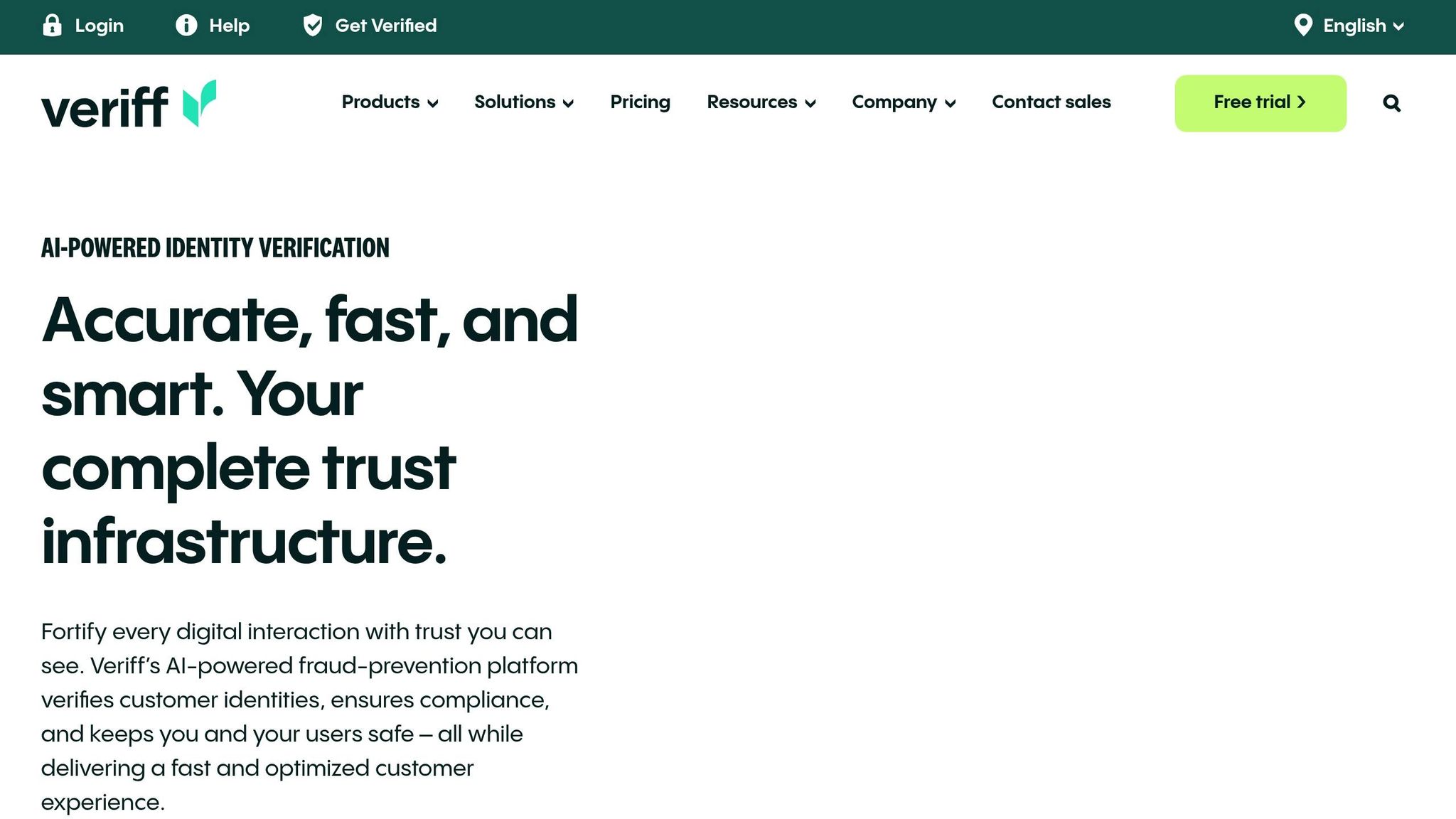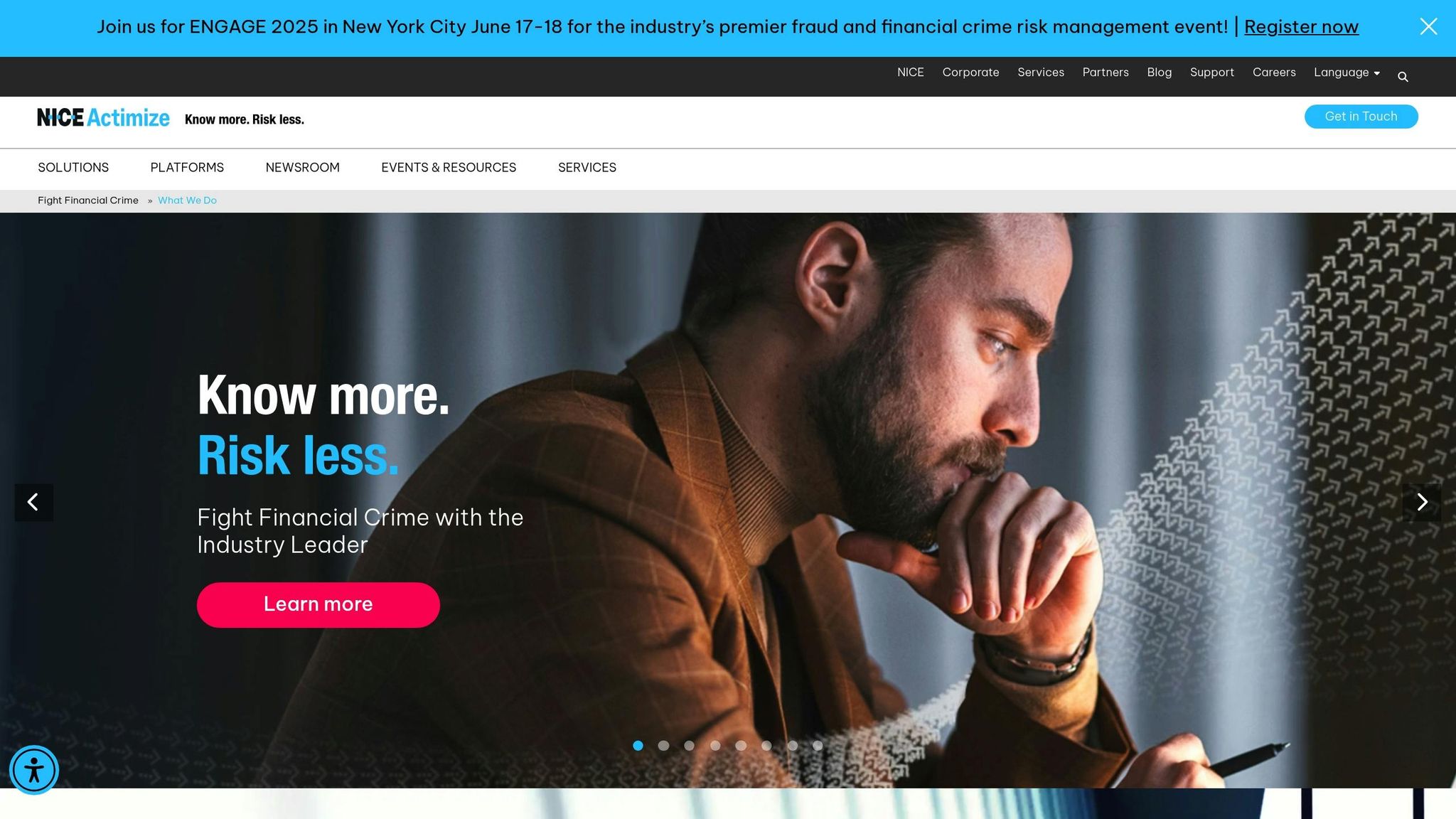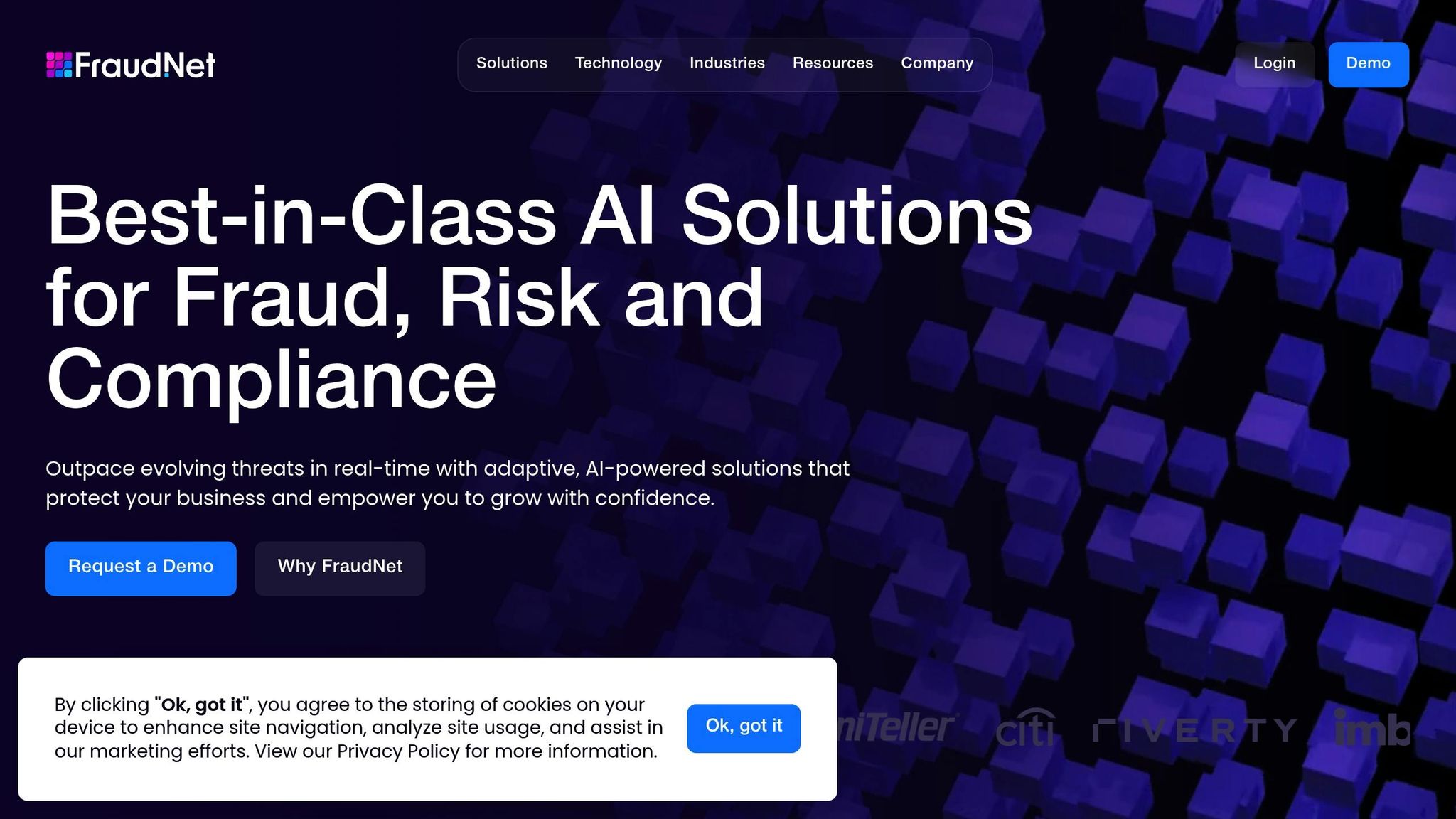
AI Voice Tools for Fraud Detection in E-Commerce
AI voice tools are transforming fraud detection in e-commerce by tackling threats like audio deepfakes and caller ID spoofing. With voice commerce projected to hit $164 billion by 2025, these tools safeguard transactions while maintaining a seamless shopping experience. Here's a quick look at five leading solutions:
- Dialzara: 24/7 AI call screening, integrates with 5,000+ apps, cuts operational costs by up to 90%.
- Veriff: Real-time identity checks, biometric authentication, reduces account takeovers by 80%-90%.
- Pindrop: Voice biometrics, deepfake detection (99% accuracy), saves $5.5M in fraud losses over three years.
- Nice Actimize: Monitors $6 trillion daily, voice biometrics reduce fraud losses by 80%.
- Fraud.net: AI-powered anomaly detection, 97% drop in false positives, scalable for growing businesses.
Quick Comparison
| Tool | Key Features | Best For | Pricing Model |
|---|---|---|---|
| Dialzara | AI call screening, real-time fraud detection | SMBs in various industries | Saves up to 90% on costs |
| Veriff | Biometric and behavioral verification | High-volume e-commerce, finance | Custom enterprise pricing |
| Pindrop | Deepfake detection, voice biometrics | Call centers, banking | Enterprise-level pricing |
| Nice Actimize | Real-time fraud monitoring, biometrics | Large financial institutions | Subscription-based enterprise |
| Fraud.net | AI fraud detection, low false positives | E-commerce, financial services | Scalable, based on volume |
These tools combine AI, biometrics, and real-time insights to fight fraud effectively while ensuring a smooth user experience. With fraud on the rise, they are essential for protecting businesses and customers alike.
1. Dialzara

Dialzara is an AI-driven virtual phone answering service tailored for e-commerce businesses. It streamlines call management by automating tasks like call screening and collecting essential call data. This helps businesses quickly identify unusual activity and take action to prevent potential fraud. Its real-time monitoring system flags suspicious call behavior instantly.
Real-time Call Screening
Dialzara’s AI receptionist works nonstop, answering calls 24/7 and recording key details from each interaction. With only 38% of business calls typically being answered, this constant availability ensures no call goes unattended, minimizing the risk of missed opportunities. This continuous coverage is especially important for catching fraudulent activity as it happens.
Integration with E-Commerce Platforms
Dialzara integrates with over 5,000 business applications, making it compatible with most e-commerce platforms and CRM systems. This wide-ranging connectivity ensures that collected call data is seamlessly transferred into existing customer databases and order systems. By keeping records updated, businesses can quickly act on any irregularities, enhancing their ability to identify and address fraud efficiently.
Pricing and Cost-Effectiveness
Dialzara is designed to save businesses money. Missed calls can result in losses exceeding $126,000 annually, but Dialzara helps minimize this by ensuring every call is handled. The platform can cut operational costs by up to 90%, thanks to its ability to manage calls without the need for extensive HR resources. Additionally, Dialzara is built with strict adherence to data protection laws, ensuring client confidentiality remains a top priority.
2. Veriff

Veriff takes a proactive approach to tackling the challenges of voice commerce by blending traditional verification methods with AI-powered, behavior-based insights. As an identity verification platform, it goes beyond basic document checks, offering advanced fraud detection designed specifically for voice-based e-commerce. By combining biometric authentication with behavioral analysis, Veriff provides a strong defense against the growing threats of digital fraud.
Real-time Anomaly Detection
Veriff employs behavioral biometrics, device analytics, and live anomaly detection to monitor suspicious activities in real time. This enables the platform to identify and block attacks - such as man-in-the-middle schemes, which have seen a 46% year-over-year increase - before transactions are finalized.
One standout feature is Veriff's FaceCheck Liveness, which uses subtle movement cues and contextual signals to detect AI-generated personas attempting to mimic real users. This is especially valuable in voice commerce, where visual confirmation is often not an option. By addressing these vulnerabilities, Veriff ensures a secure and seamless experience for voice-based transactions.
Integration with E-Commerce Platforms
Veriff offers SDKs and APIs that integrate effortlessly across desktop, mobile, and native applications. These tools analyze device and network data to block repeat offenders while minimizing false positives, ensuring legitimate transactions go through smoothly.
Machine learning plays a key role here, striking an essential balance between security and ease of use. For voice commerce, where even minor friction can deter users, this balance is critical to maintaining a positive customer experience.
Biometric Authentication Capabilities
Veriff leverages AI-driven facial biometrics to authenticate users in less than a second across platforms like iOS, Android, mobile web, and web SDKs or APIs. Its liveness detection technology is designed to spot spoofing attempts involving masks, screens, or AI-generated selfies, providing a robust layer of security.
This system has proven highly effective, with Veriff's Biometric Authentication solution reducing Account Takeover (ATO) attacks by 80% to 90% in 2024. Additionally, the platform evaluates over 30 risk signals, including behavioral, network, and device analytics, to stay ahead of evolving fraud tactics. Given that 78% of US decision-makers reported a rise in AI-driven fraud last year, these capabilities are vital for safeguarding transactions and protecting businesses.
Pricing and Cost-Effectiveness
Although Veriff doesn’t disclose specific pricing, its ability to reduce Account Takeover attacks by up to 90% delivers considerable financial savings while bolstering customer trust.
Austin Shave, CFO of Chicks Gold, shared, "Working in partnership with Veriff has doubled our security processes and increased customer satisfaction".
Veriff’s rapid authentication process - completing requests in under a second - meets the speed and convenience expectations of voice commerce users. At the same time, its ability to significantly cut down on fraud can have a meaningful impact on a company’s bottom line.
3. Pindrop

Pindrop is a voice security platform designed to protect contact centers and voice-based transactions from advanced fraud attempts. With a portfolio of over 270 voice security patents, Pindrop has established itself as a leader in securing voice commerce transactions.
Real-time Anomaly Detection
Pindrop's fraud detection system evaluates more than 1,300 audio factors to assign real-time risk scores and identify unusual activity throughout a call. It monitors calls during both the IVR (Interactive Voice Response) phase and live agent interactions, detecting suspicious behavior like robotic dialing, irregular call patterns, and unusual keypresses.
The platform also reanalyzes historical calls using updated fraud intelligence and leverages a dynamic database of confirmed fraudsters built on over 12 years of data. This approach is highly effective, with the ability to identify up to 80% of fraud cases in contact centers while keeping false positives below 0.5%. Its seamless integration into e-commerce workflows ensures efficient and secure operations.
Integration with E-Commerce Platforms
Pindrop provides pre-built integrations with major contact center platforms like Amazon Connect, Five9, Genesys Cloud CX, and NICE CXone. For instance, administrators using Five9's Numbers Inventory can implement real-time call routing instantly, bypassing delays from carrier processing.
In 2024, Pindrop and Five9 collaborated to support 15 customers in sectors like Financial Services and Healthcare. Additionally, Pindrop's integration with Bandwidth at the carrier level allows for faster transitions to cloud-based solutions.
Biometric Authentication Capabilities
Pindrop doesn’t stop at anomaly detection. Its advanced biometric verification uses the Deep Voice engine to analyze over 250 vocal characteristics, including pitch, tone, and speech patterns, while adapting to changes in voice and background noise.
The platform also includes liveness detection, which can distinguish between real human voices and recordings or synthetic voices. Its deepfake detection technology boasts a 99% accuracy rate with a false positive rate of less than 1%. The voice mismatch feature, which flags when a caller's voice doesn’t align with an enrolled profile, can be used as part of a multifactor authentication system.
"Pindrop's deepfake detection technology has demonstrated a 99 percent detection rate with a false positive rate of less than 1 percent. So our customers should be confident that very few deepfake frauds, if any, will get through in the first place", said Rahul Sood, Chief Product Officer at Pindrop.
Pricing and Cost-Effectiveness
Although Pindrop doesn’t disclose exact pricing, its impact on reducing fraud is substantial. On average, the platform helps cut fraud losses by $5.5 million over three years. In testing, Pindrop detected 22% more fraud than competing solutions while achieving a 58% lower false positive rate.
In 2023 alone, 33 Pindrop customers collectively saved around $25 million by reducing handle time costs. These savings highlight how precise fraud detection not only enhances security but also improves operational efficiency.
"Pindrop performed for us 34% better than what we projected in fraud loss cuts", shared Steve Furlong, Director of Fraud Management at First National Bank Omaha.
4. Nice Actimize

Nice Actimize strengthens fraud prevention efforts with advanced analytics and biometric verification tools, safeguarding a staggering $6 trillion daily across over 5 billion transactions. By blending machine learning with expert insights, the platform delivers cutting-edge fraud detection for voice-based transactions.
Real-time Anomaly Detection
The fraud detection system from Nice Actimize is built on a decade-long repository of predictive risk features, crafted using global customer data. This system creates detailed profiles for entities and monitors transactions in real time, identifying unusual patterns that traditional rule-based systems might miss.
This real-time monitoring ensures swift detection of fraudulent activity, particularly in voice transactions.
"Effective fraud risk management requires analytical tools, skills and capabilities to enable proper protection against constantly evolving and malicious fraud attacks", notes Nice Actimize.
These advanced detection methods integrate smoothly with major e-commerce systems, enhancing their fraud prevention capabilities.
Integration with E-Commerce Platforms
The X-Sight Marketplace by Nice Actimize acts as a hub for financial crime management, enabling businesses to evaluate and incorporate new solutions effortlessly. This ecosystem approach allows organizations to tailor fraud prevention systems to their unique needs.
For example, TF Bank, a digital banking provider for e-commerce, uses Nice Actimize AML Essentials to bolster its financial crime prevention efforts. Joanna Badawy, Head of Anti-Money Laundering at TF Bank, shared:
"As our digital bank implements an advanced anti-money laundering strategy propelled by the innovative SaaS solutions provided by NICE Actimize, we will protect our banking customers and provide greater capabilities to support our analysts as they strive to become more efficient".
Biometric Authentication Capabilities
Nice Actimize includes voice biometric authentication as a key part of its fraud prevention suite. This technology confirms customer identity by converting unique vocal features into secure voiceprints.
With accuracy rates exceeding 95%, the voice biometric system can reduce Average Handle Time by 20-40 seconds per call. Even more impressively, it can cut fraud losses by up to 80% in certain industries.
The platform’s Authentication-IQ solution uses advanced analytics to determine the most suitable authentication method based on risk levels, customer preferences, and cost considerations. This ensures that high-risk transactions are secured appropriately without inconveniencing legitimate users.
Voice biometrics work seamlessly across multiple channels, such as inbound calls, IVR systems, mobile apps, and smart devices. The system can also identify known fraudsters by comparing voices against a database of fraudulent voiceprints and flagging suspicious speech patterns.
"Today's new authentication methods, from 'selfie-recognition' to voice biometrics, are more innovative, yet more challenging to manage than ever before. In this ever-changing environment, we help our clients provide their customers with a consistent, secure multi-channel authentication experience, while reducing our clients' risk and optimizing their overall authentication costs", says Erez Zohar, VP and General Manager of Fraud & Cybercrime at Nice Actimize.
This robust authentication approach not only enhances security but also optimizes costs for businesses.
Pricing and Cost-Effectiveness
While specific pricing details aren’t disclosed, the platform’s impact on fraud reduction and operational efficiency is clear. In June 2025, KeyBank modernized its financial crime operations by adopting the Nice Actimize X-Sight AI Enterprise Platform. This upgrade introduced intelligent automation, streamlining processes and improving productivity across service areas.
Nice Actimize’s ability to process over 5 billion transactions daily, coupled with its high accuracy rates, underscores its scalability for businesses of all sizes. The X-Sight Marketplace further simplifies integration, enabling organizations to create custom solutions without starting from scratch - saving both time and implementation costs.
sbb-itb-ef0082b
5. Fraud.net

Fraud.net provides an AI-driven fraud prevention platform designed to offer real-time protection for e-commerce businesses, particularly in voice transactions.
Real-time Anomaly Detection
Fraud.net's advanced detection system continuously monitors transactions to identify unusual patterns that traditional rule-based systems might overlook. By leveraging big data analytics and live visualizations, it quickly flags and blocks suspicious activity in real time. Businesses using this system report an impressive 80% reduction in fraud and a 97% drop in false positives, ensuring legitimate customers experience minimal disruptions. For example, Fareportal successfully expanded its market reach and approved more secure transactions while minimizing risk by utilizing Fraud.net's global fraud prevention capabilities. This seamless real-time monitoring integrates effortlessly with e-commerce platforms.
Integration with E-Commerce Platforms
Fraud.net enhances its real-time detection with straightforward integration options tailored for various e-commerce environments. Its no-code/low-code integration streamlines fraud prevention, compliance, and risk management processes. The platform connects with widely used services like Twilio, FullContact, Plaid, ComplyAdvantage, and DIRO.
A satisfied user, Chris M., CEO of a Financial Services company, shared:
"The API for eCommerce and Banking are very rich in data points. As we use the product more, we shall be moving away from a rules-based engine to a more Machine learning-based engine. Also, partnering with a company like fraud.net helps us scale and offer more value to our customers".
Users also appreciate the platform's quick onboarding process and customizable rule settings. A Director of Risk & Fraud at Arvato highlighted:
"Fraud.net's flexibility has helped our AfterPay business grow by allowing us to meet our increasingly complex customer and country requirements. Their platform has enabled Arvato to increase our agility and significantly reduce fraud attacks".
Biometric Authentication Capabilities
Fraud.net strengthens voice transaction security by combining multiple detection layers, including AI-powered biometrics. These biometrics verify identities and detect anomalies in real time. The platform's Data Hub incorporates voice authentication as part of a robust, multi-layered fraud prevention system, offering enhanced security compared to standalone voice recognition.
Businesses that adopt voice-activated approval processes often see a 30–45% reduction in processing time and a 15–25% cut in administrative costs. The voice biometrics market is also on a rapid growth trajectory, projected to increase from $2.30 billion in 2024 to $15.69 billion by 2032, with a compound annual growth rate of 27.5%.
Pricing and Cost-Effectiveness
While Fraud.net does not disclose specific pricing, its ability to improve operational efficiency highlights its cost-effectiveness. For instance, Countingup, a financial services provider, achieved notable results. Their Head of Financial Crime shared:
"FraudNet's combination of customized machine learning and flexible rules management has been transformative. We've achieved significant efficiency gains while maintaining robust fraud protection - a game-changer as we navigate evolving regulatory requirements".
Fraud.net's scalable design allows businesses to start with basic fraud prevention and expand as their needs grow. The no-code integration reduces implementation expenses, and the 97% reduction in false positives directly translates into lower costs by minimizing unnecessary manual reviews.
Feature and Pricing Comparison
Choosing the right AI voice fraud detection tool requires a close look at features, pricing, and integration capabilities. In 2024 alone, companies invested a staggering $170 billion in AI technologies.
| Tool | Key Features | Integration Capabilities | Pricing Model | Best For |
|---|---|---|---|---|
| Dialzara | 24/7 AI voice answering, caller screening, call transfers; integrates with 5,000+ business apps | Works seamlessly with CRM, booking systems, and other business applications | Saves up to 90% compared to traditional hiring | SMBs in legal, healthcare, financial services, and real estate |
| Veriff | Real-time identity verification, biometric authentication, document verification | API integration with e-commerce platforms and mobile apps | Custom enterprise pricing | High-volume e-commerce and financial services |
| Pindrop | Voice biometrics, audio analysis, and behavioral pattern recognition | Integrates with telecom systems and contact centers | Enterprise-level pricing | Call centers, banking, and telecommunications |
| Nice Actimize | Machine learning fraud detection, transaction monitoring, and risk scoring | Connects with banking systems and payment processors | Subscription-based enterprise model | Large financial institutions and payment processors |
| Fraud.net | Real-time anomaly detection; reduces false positives significantly | No-code integration with Twilio, Plaid, and ComplyAdvantage | Scalable pricing based on transaction volume | E-commerce platforms and financial services |
These tools highlight the measurable advantages of AI over traditional fraud prevention methods, especially in cost savings and fraud reduction. For instance, basic AI solutions typically cost between $20,000 and $80,000, while advanced systems range from $50,000 to $150,000. Large-scale enterprise implementations can exceed $500,000. Factors like model complexity, data preparation, and infrastructure heavily influence these costs. A standout example: machine learning models used by the US Treasury saved $4 billion in 2024.
However, fraud detection costs are also shaped by sector-specific challenges. Financial institutions, for example, saw a 65% rise in fraud losses - from $2.3 million to $3.8 million - between 2022 and 2024. Similarly, 55% of e-commerce vendors reported an increase in account takeover attacks during 2021.
Real-world examples further underline AI's impact. Companies across industries report noticeable reductions in fraud and improvements in customer satisfaction. On average, AI investments yield a return of 3.5X, with some organizations seeing returns as high as 8X. The AI fraud management market reflects this confidence, projected to grow from $10.4 billion in 2023 to $57.1 billion by 2033.
Despite its efficiency, AI is most effective when paired with human expertise. By automating routine tasks like anomaly detection, AI allows analysts to focus on complex problems requiring human judgment. This collaboration is becoming increasingly vital as cyber fraud escalates - 90% of US companies reported being targeted in 2024, and 69% of respondents believe criminals are outpacing banks in their use of AI for financial crimes.
Conclusion
AI-driven voice fraud detection tools are transforming the way e-commerce handles security, offering real-time protection through advanced machine learning capable of identifying new and evolving threats.
These tools don’t just enhance security - they also improve operational workflows. By cutting down on false positives and streamlining transaction verification, businesses can save on costs while fostering stronger customer trust. The smoother processes and reduced friction create a better experience for both companies and their customers.
As discussed earlier, the fight against fraud is constantly changing. Embracing these AI solutions today equips businesses with the tools they need for long-term resilience and a stronger defense against fraud.
FAQs
How do AI voice tools help detect and prevent deepfake audio fraud in e-commerce?
AI voice tools are stepping up to tackle deepfake audio fraud in e-commerce. Using machine learning algorithms, these tools scrutinize audio for signs of tampering. They look for subtle irregularities in tone, speech patterns, and background noise - elements that often give away AI-generated voices.
By pinpointing unnatural features like mismatched emotions or uneven speech flow, these tools help determine whether a voice is genuine or fake. This added layer of security ensures safer transactions, shielding both businesses and customers from fraud in voice-based communications.
What are the key advantages of using AI voice tools for fraud detection in e-commerce?
Integrating AI voice tools into e-commerce platforms for fraud detection offers a range of benefits that can transform how businesses handle security. These tools excel at analyzing massive datasets to pinpoint fraudulent activities more accurately, which means fewer false alarms and a smoother experience for customers.
Additionally, AI-driven systems provide real-time threat detection by evaluating elements like location, device usage, and transaction patterns. This not only strengthens security but also boosts approval rates for genuine transactions while helping businesses cut down on operational expenses. With fraud detection automated, companies can concentrate on providing a shopping experience that's both secure and hassle-free for their customers.
How does voice biometrics improve security for e-commerce transactions?
Voice biometrics adds an extra layer of security to e-commerce transactions by relying on individual vocal traits to confirm someone’s identity. This approach makes it tough for fraudsters to succeed with tactics like impersonation or using fake recordings.
Modern systems go a step further with liveness detection, a feature designed to confirm that the voice is coming from a living person and not a pre-recorded clip. These capabilities work together to block unauthorized access, safeguard sensitive customer information, and minimize the chances of fraudulent transactions - particularly in critical situations where security is paramount.
Summarize with AI
Related Posts
How AI Detects Fraud in Business Phone Systems
AI is revolutionizing fraud detection in business phone systems, providing real-time monitoring and advanced security against evolving threats.
Top AI Tools for Securing Voice Commerce
Explore how AI tools enhance security in voice commerce, tackling fraud, data breaches, and ensuring safe transactions.
How AI Detects Fraudulent Documents in Real Time
AI revolutionizes document verification, offering real-time fraud detection, improved accuracy, and scalable security for small businesses.
AI Phone Agents with Voice Biometrics: Guide 2024
Explore how AI phone agents with voice biometrics enhance security, streamline authentication, and improve customer experiences in our comprehensive 2024 guide.
